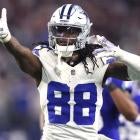
Just how good is Caleb Farley, the first prominent 2021 NFL Draft prospect to opt out of the college football season? For starters, the 6-foot-2, 207-pounder was a first team All-ACC selection as a redshirt sophomore in 2019 and received the most votes among all defensive backs.
He's a former three-star recruit per 247 Sports who was inserted into the starting lineup at Virginia Tech during his redshirt freshman season in 2018 after Adonis Alexander was picked by the Washington Football Team in the sixth round of the supplemental draft that summer after being deemed ineligible by the NCAA.
Now, let's go a little deeper on the highly-touted Farley, who'll spend the year training for the NFL instead of playing collegiate football.
Football background
Farley joined the Virginia Tech program in 2017 as an athlete -- and the plan for him was to play receiver -- but he missed the entire season due to a knee injury. He converted to cornerback in 2018 and defended seven passes while snagging two interceptions in 13 games as a full-time defender.
Last season for the Hokies, Farley asserted himself as the unquestioned star in the secondary. He knocked away 12 throws and managed four picks in just 10 games. He missed the final two contests with an undisclosed injury but did suffer from "back spasms rumored to have been caused by a pinched nerve in his back," per 247 Sports.
He primarily played on the outside in the Hokies' defense but occasionally drifted into the slot and even took snaps executing safety responsibilities in coverage last season.
Strengths
"Size-and-speed specimen" is a football phrase I don't toss around lightly in scouting reports. I save it for the truly large and explosive downfield burners. And I have no hesitation labeling Farley a size-and-speed specimen. On film, he's looks every bit as tall as his listed height of 6-2. And good luck finding a play in which he was beaten down the field. There are a few snaps in which the receiver Farley was covering got loose within the first few yards off the line, but that's when the towering cornerback's afterburners were pushed, and he recovered in a flash. Amazing to watch.
But being tall and fast doesn't a cornerback make. And Farley's twitch is tremendous. He explodes after planting his foot when changing directions, and his gelatin-like hips allow him to fluidly maneuver while mirroring. All of that together provides Farley with a vital element of playing the cornerback position: confidence. He's not jittery in press, a hyper-aggressive, boom-or-bust style that produces smothering reps and misses early in the play that lead to big gains for the offense. He often allows a receiver to make his head/shoulder/hip fake then reacts like lightning, essentially closing the separation gap in an instant. Farley is also very keen at pressing outside receivers near the sideline or out of bounds completely when running stride-for-stride with them deep, and his awareness as the ball is arriving is that of a veteran corner. He has high-end man-to-man capabilities and the ideal frame and physical talents to be deployed in zone.
Weaknesses
Because he's so tall and blessed with special athletic gifts, Farley's backpedal would technically be considered "high." NFL defensive back coaches want to see a low, crouched retreat from their corners, but some high-caliber athletes (like Farley) can get away with their hips not so close to the ground at the start of the play.
He's flashy as a blitzer and in run support, yet it's apparent Farley doesn't like to get after it as much in either of those facets as he does blanketing a receiver down field or click-and-closing on an in-breaking route in front of him in zone.
NFL comparison
Floor: Prince Amukamara
Middle: Bradley Roby
Ceiling: Byron Jones
I'm going with a floor / middle ground / ceiling comparison for Farley because I felt like it'd give a good general idea of the type of player he is and provide a broad range of outcomes for his level of success in the NFL when considering factors outside his control (coaching, scheme, etc.) once he gets to the league.
Amukamara was the first corner picked in the 2011 draft after thriving as a fast, ultra-athletic man corner at Nebraska. While he's never made a Pro Bowl in his nine pro seasons, the 6-foot-1 corner has had 10-plus pass breakups in five separate years and a pair of three-pick campaigns. He can play.
Roby was a first-round pick in 2014 out of Ohio State, and like Amukamara, ran sub-4.4 at his combine. Also like Amukamara, his flashes are elite even though he's not super consistent. Roby has logged double-digit pass breakups in four of his six seasons in the NFL with a total of nine interceptions to date.
Jones, a first-round selection in 2017, would be the high benchmark for Farley. The shiny free-agent signing by the Miami Dolphins is probably more explosive than Farley with a slightly stiffer midsection. He was a second-team All-Pro in 2018 with the Dallas Cowboys and has emerged as one of the most reliable, big corners in the NFL.
Farley has the size and on-field traits closely comparable to all three of those corners, and, like them, will land in the first round of the NFL Draft. Because he's tall and so talented, he'll enjoy a long, successful pro career.


















